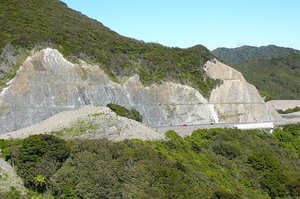Advertisement
Published: December 17th 2012

 Engineering solutions
Engineering solutions
Good examples for GL3 geology moduleBreakfast al fresco today before our journey to Napier. However, enroute a stop off for an hour at another iconic geological feature that I have been teaching about for so many years; Pigeon Bush.
To get there we had to cross the Rimutaka Range which had some excellent engineering solutions to the problems posed to road design in such high and steep areas. The range is up to 1000 metres high and is part of the chain of mountains forming the backbone of North Island. Pigeon Bush is a non-descript location in farmland along the Wairarapa Fault. Here a small fault scarp is cut by a small stream to produce a pronounced small gorge. The stream then continues across the flat fields beyond. To the SW are two small dry stream channels which seem to have no surface feature at the scarp from where they seem to start. Harold Wellman was the first to interpret this in 1988 as another example of strike-slip faulting with a horizontal movement of the Wairarapa Fault to the right (dextral). The movement in the offset of the channels from the present channel that I measured was 18 and 32 metres!
The nearest channel

 Pigeon Bush site
Pigeon Bush site
The Wairarapa Fault Scarp with current stream channel and 2 offset dry channels to the left.offset (18 metres) is attributed to the 1855 earthquake along the Wairarapa Fault which is recorded in history. This means the channel was moved sideways by 18 metres instantly during that quake! The other channel shows the lateral movement to be 14 metres. Movement on this scale was previously unknown though movement has since been recorded in Mongolia of up to 14.8 metres in one go.
However, not only was the movement horizontal but there was also a vertical component of up to 2 metres during the earthquake. The inevitable conclusion is that the mountains of the Rimutaka Range are very young in origin and have been pushed up during successive earthquakes in the only the last 250,000 years!
Movement on this scale can now be attributed to plate tectonics but it reminds me (and hopefully my students!) that compressive forces can create mountains not only by folding but also by faulting.
Those whom I teach will get this lesson, already practised on the cows, again on my return!
Advertisement
Tot: 0.082s; Tpl: 0.011s; cc: 7; qc: 44; dbt: 0.0536s; 1; m:domysql w:travelblog (10.17.0.13); sld: 1;
; mem: 1.1mb

 Engineering solutions
Engineering solutions
 Pigeon Bush site
Pigeon Bush site


